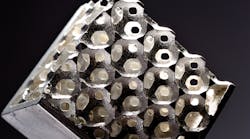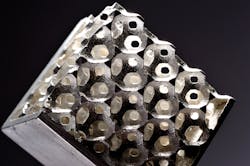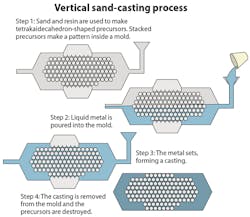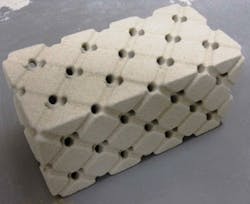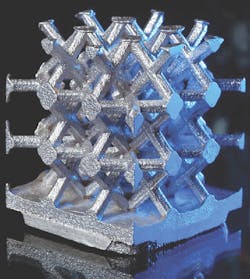Metal foams, also called cellular materials, are metallic bodies with interdispersed voids called cells. They have a reputation for high strength, low density, and absorbing impact. This combination works well for military vehicles where lighter parts can save money and the degree of impact cushioning can be the difference between life or death.
Traditionally made metal foam is stochastic, meaning the foam has irregular cells that are spaced unevenly. If the cell structure in metal foam is arranged and regular it is called ordered-cell foam. Stochastic materials reduce weight as do ordered-cell metal foams. However, ordered-cell foam has superior strength, stiffness, energy absorption, and it moves heat.
While there are several methods of making ordered-cell foam, one company is seeing consistent results by making it through the process of sand casting. The problem is that current methods of making sand-casting patterns are from the age of subtractive machining processes where part features must be relatively simple. Now, researchers are testing additive manufacturing to make complex sand castings which could create a new breed of ordered-cell metal foams.
Mixing old and new techniques
The researchers are from the Design, Research, & Education for Additive Manufacturing Systems (DREAMS) Laboratory at Virginia Polytechnic Institute and State University, and the Virginia Tech Foundry Institute for Research and Education (VT FIRE). And what they’re studying is mesoscopic topology. Basically, this is the geometric arrangement of the solid phases and voids ranging from 0.1 to 10 mm within a material or product.
Originally the team considered direct-metal additive manufacturing methods to make ordered-cell metal foam. Methods include selective laser melting, electron-beam melting, and direct-metal laser sintering. While these methods can fabricate parts with cellular geometries, unfortunately each option posed such limitations as a lack of compatible working materials, the need for support structures which are difficult to remove, and cost. At the end of the day, the team decided these techniques are incapable of fabricating metal foam for large-scale applications.
In addition, the team looked into tried-and-true methods of making ordered-cell foam. Common methods include stamping or crimping thin sheets of metal into a corrugated shape and joining them to create periodic structures, joining and bonding slotted metal sheets, extrusion and electrodischarge machining, and weaving and brazing metal filaments to form a periodic textile. Each method creates repeatable part quality, but they limit the macrostructure of parts to planar geometries and constrain designers to use a specific homogeneous mesostructure throughout a part.
Sand casting of foams is a relatively new method dating to 10 years ago when a French research organization, Centre Technique des Industries de la Fonderie, wanted to develop a foam that could be manufactured using foundry methods. The development led to a patent in 2008. Today, a company called Goodfellow Corp., Coraopolis, Pa., has released an ordered-cell metal foam made using the technique found in the patent. Goodfellow says it has the first commercially available metal foam made by sand casting. This is also said to be the first foam with a defined, reproducible, regular structure.
The sand-casting method uses stacked precursors where shapes of sand are produced and then stacked in a mold. The mold fills with liquid metal, the metal solidifies, and then the sand shapes are removed, leaving the metal foam.
As with any process, the sand-casting method has its limitations. The maximum-use temperature is dictated by the melting point of the metal/alloy used. The cell structure is limited by the ability of the sand to escape the metal foam. And the height of the cast piece is limited by the size of the mold, but this limitation can be overcome by stacking molds.
Commercially available sand-cast foam
To make the sand-cast metal foam, Goodfellow uses traditional casting techniques. The interesting part of the process pertains to the shapes of the sand precursors. They are shaped as tetrakaidecahedrons — polygons with 14 faces — eight hexagonal and six square. This gives a regular, open 3D structure. The precursors are made by mixing sand with resin. After the metal fills the pattern, the precursors are destroyed, leaving a metal foam composed of evenly spaced, stacked 10-mm open-pore cells.
In traditional sand casting, the minimum ligament diameter is often limited to around 3 mm when filling the mold using gravity. The foams offered by Goodfellow can have a ligament diameter as small as 1 mm. Each manufactured piece is identical to and has the same behavior as other pieces made from the same casting. The process lets the manufacturer customize the size and space of the pores to meet the needs of the application.
Two major needs the foam satisfies are impact absorption and heat exchange. For impact absorption, the sand- casting method lets designers create customized structures necessary to absorb a specific amount of energy. But Goodfellow says the degree of impact absorption depends on the material used to create the foam. Aluminum offers qualities like cost, heat transfer, and strength. With pure aluminum, the foam has a fracture strength of 70 MPa. It is also possible to manufacture the foams with the same structure in iron or copper.
Heat moves through Goodfellow’s sand-cast metal foam because the material has a high porosity of 80 to 90%. It also has a high relative surface area, up to 500 m2/m3, which facilitates the movement of fluids and the recovery of heat, even at low speeds. The lightweight metal foam has the ability to mix fluids and, therefore, is able to homogenize temperature. This is particularly important in oils, where the high viscosity can limit mixing.
Metal foam’s ability to move heat paired with its light weight makes it a candidate for cooling electronic components. Goodfellow says the first industrial application for its aluminum foam was in cooling LEDs. Metal foam also works in automobiles to cut weight and absorb impact. Some metal foams can be found in crash-conscious applications like military vehicles.
Goodfellow’s sand-cast aluminum foam comes in sheets of 40 × 100 × 172 mm. The cell size is 10 mm and one surface comes clad in a solid aluminum sheet. It is possible to specify other sizes of foam without a solid cladding on one surface. As with all aluminum, the foam can be painted, anodized, or left in its natural state.
Binder jet 3D printing sand molds
While the process of sand casting is still one of the least expensive ways to make large objects, the Virginia Tech work could provide a more economical hybrid technique by eliminating the costs associated with pattern tooling. In addition, the hybrid technique allows for greater design freedom, letting designers alter mold geometry, integrate gating systems, and embed cores.
The Virginia Tech team used indirect 3D printing, now called binder jet 3D printing by ASTM, to make the molds. Binder jet 3D printing is a process that creates parts through the deposition of binder into a powder bed of raw material. To make a sand-cast part, they started by designing 3D models of the desired metal parts using Netfabb’s Selective Space Structures software. They designed three shapes of metal parts, each with an internal structure based on octet-trusses. A Boolean subtraction then created the shape of the mold.
Using a Z Corp. Spectrum Z510, they printed molds from ViriCast 170LE powders and Z Corp.’s ZCast501 powders. Both powders are types of synthetic sand casting material. They left the molds in the powder bed for an hour to let the jetted binder cure. Then the molds were heat treated at 250°F for 2.5 hr with an additional bake at 450°F for almost 2 hr to ensure the molds were free from moisture.
Exterior molds, which hold the liquid metal around the sand mold, were made from traditional foundry methods but the team says additive printing could be used. A356, a common aluminum alloy used in safety and automotive applications, was poured at around 1,380°F. A quick-fill gating system design did not fill the mold correctly, so the metal was poured through a ceramic foam filter to help slow the flow.
After the castings set, the mold was easily broken and the castings were lightly cleaned. They were given a standard T6 heat treatment at 1,005°F in an air-circulating furnace for about 11 hr. They were then quenched in a bucket of room-temperature water and artificially aged at 310°F for 5 hr.
The results prove the hybrid technique will need further development. While the final castings weighed less than a completely filled part, they were not of uniform quality in fill and diameter. There were a few castings with several unfilled trusses, as well as 0.1-mm-diameter porous defects. One casting had trusses that were 13.5% larger and 10.8% smaller than the average truss. This may seem like a large range, but the team notes the deviations are within the standard error of the casting process.
Researchers tested the mechanical properties of the octet structure within a cubic geometry. The team took a cubic casting with completely filled trusses and little to no flash and compression-tested it at a rate of 1.5 mm/sec. It withstood a maximum load of 64 kN before the trusses began to fail with about 6 mm of displacement.
When asked about next steps for the research, Dr. Christopher Williams of Virginia Tech stated, “In addition to refining the process, we are investigating different cellular topologies to further improve the structures’ ability to mitigate blasts. We are also exploring the inclusion of ceramic materials into the structure that could provide ballistic protection as well as blast protection.”
Resources:
Dr. Christopher Williams. Design, Research, and Education for Additive Manufacturing Systems Laboratory Department of Mechanical Engineering Virginia Polytechnic Institute and State University, http://utwired.engr.utexas.edu/lff/symposium/proceedingsArchive/pubs/Manuscripts/2012/2012-11-Meisel.pdf
Goodfellow Corp., goodfellowusa.com
